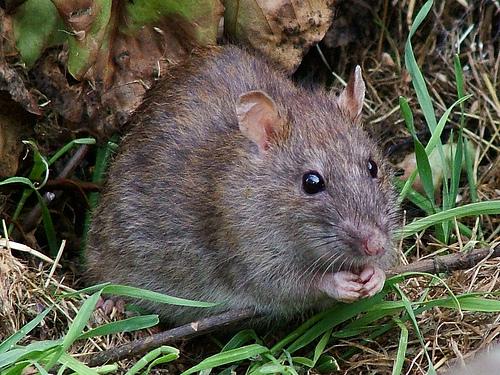Rodents and Schools
On this page:
Overview and Life Cycle of Rodents
- The two most common pest rat species in the United States, both introduced from Europe, are the Norway rat and the roof rat.
- The Norway rat, Rattus norvegicus, considered the most common rat in the United States, is also known as the:
- brown;
- wharf;
- house;
- gray; or
- sewer rat.
- The Norway rat can be found in every state. This species was introduced to the United States in 1775. They are nocturnal and tend to stay within 300 feet of their nest.
- These rats are between 13 and 18 inches in length and have scruffy brown fur on its back and legs, and gray, white or yellow fur on its stomach.
- The roof rat, R. rattus, also known as the ship, black, or Alexandrine rat, occurs mainly along the coastal United States.
- It is smaller and thinner than the Norway rat and has a pointier muzzle. The roof rat also has larger ears and its fur can be light brown to black.
Rodent Life Cycle: Females have litters in the spring and fall and produce 6 to 12 pups.
Health Concerns

Rat
Rodents spread more than 35 diseases. These diseases can be spread to humans:
- directly, through handling of rodents;
- through contact with rodent feces, urine, or saliva; or
- through rodent bites; and
- indirectly, through ticks, mites or fleas that have fed on an infected rodent.
The following are examples of infections and health issues that are caused by indirect or direct contact with rodents and cockroaches:

Rodent
Photo Credit: USDA
Photo Credit: USDA
- Hantavirus Pulmonary Syndrome (HPS) (can be caused by contact with urine, droppings, and saliva) - CDC
- Murine Typhus (can be caused by fleas on rodents) Exit - Texas Department of State Health Services
- Rat-bite fever (RBF) - National Institutes of Health
- Leptospirosis (generally caused by contact with urine) - CDC
More information about diseases from rats caused by:
Rodent Management Tips
- Don’t allow dirty supplies to pile up and become clutter.
- Keep food scraps in the refrigerator or in containers with tight-fitting lids.
- If pets are in the classroom, keep the pet food in tightly sealed containers, and do not allow food to remain in the bowls overnight. Feed only what the animal will eat at the time of feeding.
- Remove garbage from the classroom on a routine basis. Keep outside containers covered, especially at night.
- Periodically check and clean the evaporation pan under the refrigerator or freezer.
Resources on Rodents
- Identify and Prevent Rodent Infestations.
- About Rats and Mice.
- Information on the Norway rat and the roof rat, Exitfrom the University of California.
- The CDC's Rodents Hub - This page identifies prevention strategies, diseases that are directly and indirectly transmitted by rodents, and provides helpful contact information.
- IPM for Rodents in Schools (PDF)(3 pp, 45 K, About PDF) Exit - A 3-page brochure developed by IPM for Pennsylvania Schools.
- IPM for Schools: Training Manual Exit - Comprehensive training document developed by the Maryland Department of Agriculture for the Maryland Public School Sysytem.
- IPM Action Plan for Rodents Exit - This has tips on removal, baits, both chemical and nonchemical, and disposing of rodents as well as other general information.
- Read more about integrated pest management.
